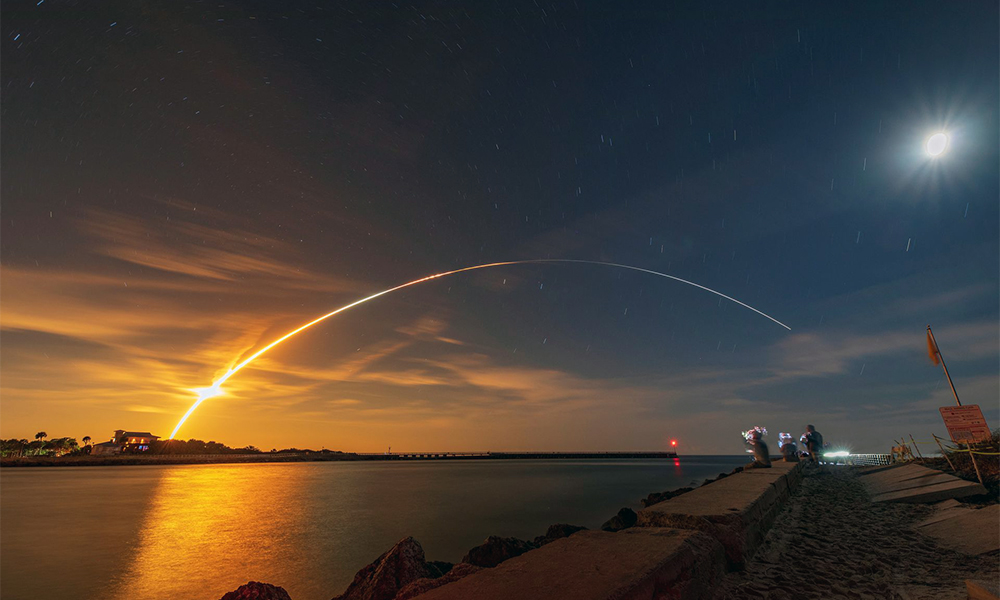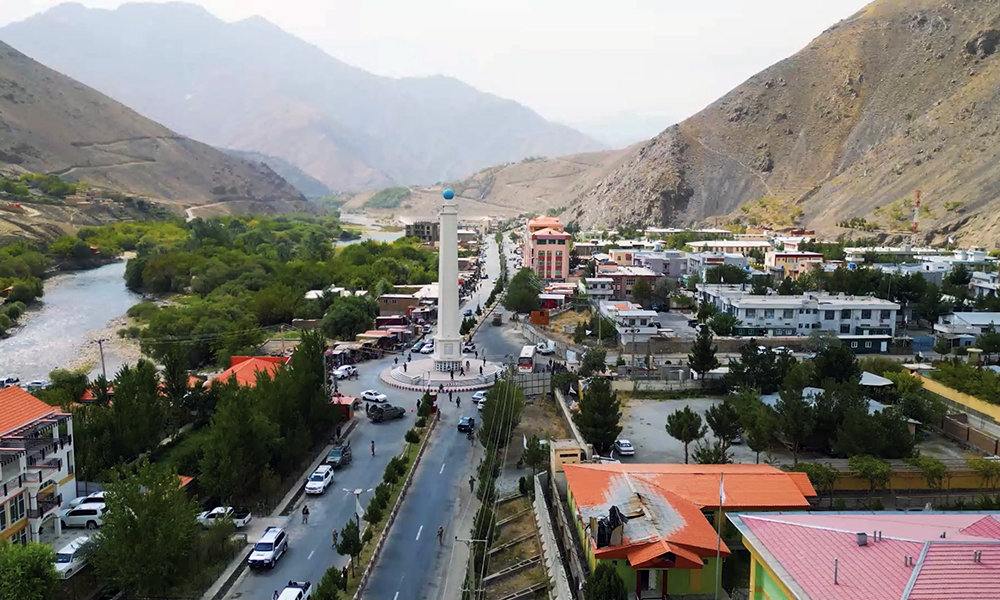Science & Technology
NASA’s Orion capsule heads for splashdown after Artemis I flight around moon

NASA’s uncrewed Orion capsule hurtled through space on Sunday on the final return leg of its voyage around the moon and back, winding up the inaugural mission of the Artemis lunar program 50 years to the day after Apollo’s final moon landing.
The gumdrop-shaped Orion capsule, carrying a simulated crew of three mannequins wired with sensors, was due to parachute into the Pacific at 9:39 a.m. near Guadalupe Island, off Mexico’s Baja California peninsula, Reuters reported.
Orion was nearing the end of its 25-day mission less than a week after passing about 127 km above the moon in a lunar fly-by and about two weeks after reaching its farthest point in space, nearly 434,500 km from Earth.
After jettisoning the service module housing its main rocket system, the capsule was expected to re-enter Earth’s atmosphere at 39,400 kph — more than 30 times the speed of sound — for a fiery, 20-minute plunge to the ocean.
Orion blasted off on November 16 from the Kennedy Space Center at Cape Canaveral, Florida, atop NASA’s towering next-generation Space Launch System (SLS), now the world’s most powerful rocket and the biggest NASA has built since the Saturn V of the Apollo era.
By coincidence, the return to Earth of Artemis I unfolded on the 50th anniversary of the Apollo 17 moon landing of Gene Cernan and Harrison Schmitt on December 11, 1972. They were the last of 12 NASA astronauts to walk on the moon during a total of six Apollo missions starting in 1969.
Re-entry marks the single most critical phase of Orion’s journey, testing whether its newly designed heat shield will withstand atmospheric friction expected to raise temperatures outside the capsule to nearly 2,760 degrees Celsius.
“It is our priority-one objective,” NASA’s Artemis I mission manager Mike Sarafin said at a briefing last week. “There is no arc-jet or aerothermal facility here on Earth capable of replicating hypersonic re-entry with a heat shield of this size.”
It will also test the advanced guidance and thruster systems used to steer the capsule from the moon to its proper re-entry point and through descent, maintaining the spacecraft at just the right angle to avoid burning up.
“It’s essentially like throwing a football 300 yards and hitting a penny,” Eric Coffman, Orion propulsion senior manager at Lockheed Martin Corp, which built Orion under contract with NASA, told Reuters.
Science & Technology
‘Massive cyberattack’ brings down Elon Musk’s X
Digital Trends reported Tuesday that there are reports suggesting X is still having issues

Social media platform X went down intermittently on Monday, with owner Elon Musk blaming an unusually powerful cyberattack.
“We get attacked every day, but this was done with a lot of resources. Either a large, coordinated group and/or a country is involved,” Musk said in a post on X on Monday.
He did not clarify exactly what he meant by “a lot of resources” and his comments drew skepticism from cybersecurity specialists, who pointed out that attacks of this nature — called denials of service — have repeatedly been executed by small groups or individuals.
X faced intermittent outages, according to Downdetector, Reuters reported.
Digital Trends meanwhile reported Tuesday that there are reports suggesting X is still having issues.
Internet industry experts have said X was hit by several waves of ‘denial of service’ throughout Monday.
Musk said in an interview with Fox Business Network’s Larry Kudlow the cyberattack came from IP addresses originating in the Ukraine area.
An industry source told Reuters he disputed Musk’s account, saying that large chunks of the rogue traffic bombarding X could be traced back to IP addresses in the United States, Vietnam, Brazil and other countries, and that the amount of rogue traffic coming directly from Ukraine was “insignificant.”
In any case, denial of service attacks are notoriously hard to trace back to their authors and the IP addresses involved rarely provide any meaningful insight into who was behind them, Reuters reported.
Musk has joined U.S. President Donald Trump, whom he serves as an adviser, in criticizing Ukraine’s continued efforts to fight off a Russian invasion.
Musk said on Sunday that Ukraine’s front line “would collapse” without his Starlink satellite communications service, though he said he would not cut off Ukraine’s access to it.
Science & Technology
NASA says ‘city killer’ asteroid has a 3.1 % chance of striking Earth in 2032
Despite the rising odds, experts say there is no need for alarm

An asteroid that could level a city now has a 3.1-percent chance of striking Earth in 2032, according to NASA data released Tuesday — making it the most threatening space rock ever recorded by modern forecasting.
Despite the rising odds, experts say there is no need for alarm. The global astronomical community is closely monitoring the situation and the James Webb Space Telescope is set to fix its gaze on the object, known as 2024 YR4, next month.
“I’m not panicking,” Bruce Betts, chief scientist for the nonprofit Planetary Society told AFP.
“Naturally when you see the percentages go up, it doesn’t make you feel warm and fuzzy and good,” he added, but explained that as astronomers gather more data, the probability will likely edge up before rapidly dropping to zero.
2024 YR4 was first detected on December 27 last year by the El Sauce Observatory in Chile.
Astronomers estimate its size to be between 130 and 300 feet (40–90 meters) wide, based on its brightness. Analysis of its light signatures suggests it has a fairly typical composition, rather than being a rare metal-rich asteroid.
The International Asteroid Warning Network (IAWN), a worldwide planetary defense collaboration, issued a warning memo on January 29 after the impact probability had crossed one percent. Since then, the figure has fluctuated but continues to trend upward.
NASA’s latest calculations estimate the impact probability at 3.1 percent, up from 1.6 percent last month, with a potential Earth impact date of December 22, 2032.
Richard Moissl, head of the European Space Agency’s planetary defense office, which puts the risk slightly lower at 2.8 percent told AFP that this “is not a crisis at this point in time. This is not the dinosaur killer. This is not the planet killer. This is at most dangerous for a city.”
If the risk rises over 10 percent, IAWN would issue a formal warning, leading to a “recommendation for all UN members who have territories in potentially threatened areas to start terrestrial preparedness,” explained Moissl.
Unlike the six-mile-wide (10-kilometer-wide) asteroid that wiped out the dinosaurs 66 million years ago, 2024 YR4 is classified as a “city killer” — not a global catastrophe, but still capable of causing significant destruction.
Its potential devastation comes less from its size and more from its velocity, which could be nearly 40,000 miles per hour if it hits.
If it enters Earth’s atmosphere, the most likely scenario is an airburst, meaning it would explode midair with a force of approximately eight megatons of TNT — more than 500 times the power of the Hiroshima bomb.
But an impact crater cannot be ruled out if the size is closer to the higher end of estimates, said Betts.
The potential impact corridor spans the eastern Pacific, northern South America, the Atlantic, Africa, the Arabian Peninsula, and South Asia — though Moissl emphasized it is far too early for people to consider drastic decisions like relocation.
The good news: there’s ample time to act.
NASA’s 2022 DART mission proved that spacecraft can successfully alter an asteroid’s path, and scientists have theorized other methods, such as using lasers to create thrust by vaporizing part of the surface, pulling it off course with a spacecraft’s gravity, or even using nuclear explosions as a last resort. — Agence France-Presse
Science & Technology
Panjshir will soon be connected to national fiber optic network
The statement said that this project covers a 36-kilometer route from Gulbahar to Bazarak, and the districts of Shatal, Anaba and Rukha will also benefit from fiber optic services.

The Panjshir provincial media office said in a statement on Wednesday, February 1 that practical work was to connect the province to fiber optic will begin within the next month.
The statement said that this project covers a 36-kilometer route from Gulbahar to Bazarak, and the districts of Shatal, Anaba and Rukha will also benefit from fiber optic services.
The statement added that the project is being implemented by Afghan Wireless, Afghan Telecom and ICG companies as a result of the efforts of the Panjshir provincial administration and the special attention of the leadership of the Ministry of Communications and Information Technology of the Islamic Emirate of Afghanistan.
-

 Sport4 days ago
Sport4 days agoIPL 2025 celebrates 18 years of immense success
-

 World4 days ago
World4 days agoPutin agrees to 30-day halt on energy facility strikes in Ukraine
-

 Latest News4 days ago
Latest News4 days agoBayat Foundation helps needy families in Kabul during Ramadan
-

 Latest News4 days ago
Latest News4 days agoTorkham crossing to reopen after 25-day shutdown
-

 Latest News3 days ago
Latest News3 days agoHelmand environmental department opens new Zoo
-

 Latest News4 days ago
Latest News4 days agoAfghan-Pakistan talks to reopen Torkham border ‘end on positive note’
-

 Latest News2 days ago
Latest News2 days agoAfghan prisoners in Iran sent home
-

 Latest News3 days ago
Latest News3 days agoRights watchdog calls on Pakistan to ‘immediately stop’ forced deportations of Afghan refugees
























